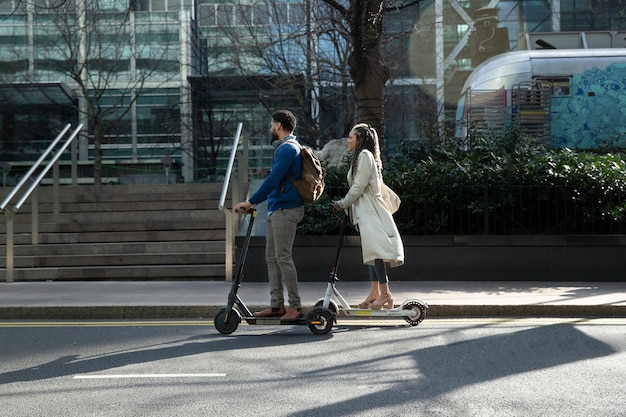Emerging Business Models in US Shared Mobility Market: Disruption Ahead

Emerging business models in the shared mobility market, such as micro-mobility services, ride-sharing platforms, and subscription-based transportation, are poised to disrupt traditional transportation services in the US by offering more flexible, convenient, and cost-effective alternatives to car ownership and conventional public transit.
The US transportation landscape is undergoing a dramatic transformation. The rise of the shared mobility market and its innovative business models are challenging the status quo. Let’s explore what are the emerging business models in the shared mobility market and their potential to disrupt traditional transportation services in the US.
Understanding the Shared Mobility Landscape in the US
Shared mobility is revolutionizing how Americans move, offering alternatives to traditional car ownership. The concept encompasses various transportation services that allow users to access vehicles on an as-needed basis, reducing reliance on personal vehicles.
This trend is driven by several factors, including urbanization, increasing traffic congestion, environmental concerns, and the desire for more flexible and affordable transportation options.
Key Components of Shared Mobility
The shared mobility ecosystem comprises several key components, each with its unique business model and target audience.
- Ride-sharing: Platforms like Uber and Lyft connect passengers with drivers, offering on-demand transportation services.
- Car-sharing: Services like Zipcar allow users to rent cars for short periods, typically by the hour or day.
- Micro-mobility: This category includes shared electric scooters and bikes, providing convenient transportation for short distances.
- Subscription-based mobility: Bundled transportation services offering access to various modes of transport for a recurring fee.
These components are not mutually exclusive and often overlap, creating a complex and evolving market.
Each of these elements impacts the urban environment and traditional transportation models in unique ways, fostering both opportunities and challenges for cities and consumers.

Shared mobility represents a paradigm shift in urban transportation, driven by technological advancements and changing consumer preferences.
Ride-Sharing Platforms: Reshaping Urban Transportation
Ride-sharing platforms have become a ubiquitous part of the urban transportation landscape in the US. Companies like Uber and Lyft have transformed how people commute, travel, and access transportation.
These platforms leverage technology to connect riders with drivers, offering convenient and on-demand transportation services.
Impact on Traditional Taxi Services
Ride-sharing platforms have significantly disrupted traditional taxi services, offering several advantages that appeal to consumers.
- Convenience: Ride-sharing apps allow users to request rides from their smartphones, eliminating the need to hail a taxi or wait at a taxi stand.
- Transparency: Riders can see the estimated fare and route before booking a ride, providing greater transparency and predictability.
- Payment Options: Ride-sharing platforms offer cashless payment options, making it easier for users to pay for their rides.
The convenience, transparency, and ease of use of ride-sharing platforms have led to a decline in the demand for traditional taxi services.
Ride-sharing’s convenience and transparency have made it a preferred option for many, impacting traditional taxi services significantly.
Challenges and Criticisms
Despite their popularity, ride-sharing platforms face several challenges and criticisms.
- Driver Compensation: Concerns have been raised about the compensation and benefits provided to ride-sharing drivers, who are often classified as independent contractors.
- Safety Concerns: Issues related to passenger safety and driver screening have been a topic of discussion.
- Regulation: Ride-sharing platforms have faced regulatory challenges in various cities and states, with debates over insurance requirements and licensing.
These challenges highlight the need for ongoing dialogue and collaboration between ride-sharing companies, regulators, and community stakeholders.
Although ride-sharing offers many benefits, addressing these challenges is imperative for its sustainable and ethical growth.
Ride-sharing platforms are changing the way people move in cities, offering both opportunities and challenges for urban transportation.
Micro-Mobility Solutions: Scooters and Bikes
Micro-mobility solutions, such as shared electric scooters and bikes, have emerged as a popular transportation option in many US cities. These services offer a convenient and eco-friendly way to travel short distances.
The rise of micro-mobility is driven by the desire for sustainable transportation alternatives and the need to address the “last mile” problem – connecting commuters from transit hubs to their final destination.
Benefits of Micro-Mobility
Micro-mobility solutions offer several benefits for urban residents and cities.
- Reduced Congestion: Scooters and bikes can help alleviate traffic congestion, particularly during peak hours.
- Environmental Benefits: Electric scooters and bikes produce zero emissions, contributing to cleaner air and reduced carbon footprint.
- Affordability: Micro-mobility services can be more affordable than other transportation options, such as taxis or ride-sharing.
These benefits have made micro-mobility an attractive option for commuters, tourists, and urban dwellers.
By offering a convenient, sustainable, and affordable way to travel, micro-mobility is reducing urban congestion and promoting cleaner air.
Challenges and Safety Concerns
Despite their popularity, micro-mobility solutions face several challenges, including safety concerns and regulatory hurdles.
- Safety Risks: Accidents involving scooters and bikes have raised concerns about rider safety and pedestrian safety.
- Infrastructure: Many cities lack dedicated bike lanes and scooter parking, leading to safety and logistical issues.
- Regulation: Cities are grappling with how to regulate micro-mobility services, including permitting, speed limits, and parking restrictions.
Addressing these challenges is crucial for the long-term success and integration of micro-mobility into the urban transportation ecosystem.
By creating safe infrastructure and establishing clear regulations, cities can harness the benefits of micro-mobility while mitigating the risks.

Micro-mobility solutions are transforming urban transportation, offering a sustainable and convenient way to navigate cities.
Subscription-Based Mobility: A New Approach
Subscription-based mobility is an emerging business model that offers users access to a bundle of transportation services for a recurring fee. This approach aims to simplify transportation by providing a single, integrated solution.
These subscriptions can include access to public transit, ride-sharing, car-sharing, and micro-mobility, offering users a flexible and convenient way to get around.
Benefits of Subscription Models
Subscription models offer several advantages for both consumers and transportation providers.
- Convenience: Users can access multiple transportation modes through a single subscription, streamlining their travel experience.
- Cost Savings: Subscription models can offer cost savings compared to paying for each transportation service individually.
- Flexibility: Users can choose a subscription plan that best suits their needs, allowing them to customize their transportation options.
Subscription-based mobility is becoming an increasingly appealing option for urban dwellers seeking integrated and convenient transportation.
By offering flexible and cost-effective solutions, subscription models are simplifying transportation and meeting the evolving needs of urban travelers.
Challenges and Implementation
The implementation of subscription-based mobility faces several challenges, including integration and interoperability.
Integrating various transportation services into a single platform requires collaboration between different providers. This can be complex due to technological and business differences.
Ensuring interoperability between different systems and payment methods is another challenge that needs to be addressed.
Addressing these challenges is crucial for the successful implementation and scalability of subscription-based mobility.
With careful planning and collaboration, subscription models can transform urban transportation and create a more seamless travel experience.
Subscription-based mobility is an innovative approach to transportation, offering users a convenient and cost-effective way to access multiple modes of transport.
The Potential Impact on Traditional Car Ownership
The rise of shared mobility is poised to disrupt traditional car ownership in the US. As transportation options become more diverse and accessible, the need to own a personal vehicle may diminish.
Shared mobility offers a range of alternatives to car ownership, including ride-sharing, car-sharing, micro-mobility, and subscription-based services.
Factors Influencing Car Ownership
Several factors influence the decision to own a car, including cost, convenience, and emotional attachment.
Car ownership entails significant expenses, including purchase price, insurance, maintenance, and fuel. Shared mobility can offer cost savings by eliminating these expenses.
The convenience of having a car readily available has traditionally been a major factor in car ownership. However, shared mobility services offer on-demand transportation that can be just as convenient.
Despite the practical considerations, emotional attachment to cars remains a strong influence for many people to continue owning cars.
As shared mobility becomes more widespread and reliable, the perceived benefits of car ownership may decline.
The convenience and variety of shared mobility options increasingly challenge the need to own a car.
The Future of Car Ownership
The future of car ownership is uncertain, but it is likely that shared mobility will play an increasingly important role in transportation.
As cities become more congested and parking becomes more scarce, shared mobility offers a viable alternative to car ownership.
Technological advancements, such as self-driving cars, could further accelerate the adoption of shared mobility and reduce the demand for personal vehicles.
Shared mobility can dramatically change how Americans think about and use transportation.
Traditional car ownership could be significantly different in the future as shared mobility models continue to evolve.
Shared mobility has the potential to reshape the transportation landscape and reduce reliance on personal car usage.
Challenges and Opportunities in the Shared Mobility Market
The shared mobility market presents both challenges and opportunities for businesses, cities, and consumers. Overcoming the challenges and capitalizing on the opportunities will be crucial for the sustainable growth and integration of shared mobility.
One of the main challenges is regulation. Cities need to create clear and consistent regulations for shared mobility services to ensure safety and fairness, without stifling innovation.
Regulatory Frameworks and Safety Standards
Developing appropriate regulatory frameworks and safety standards is essential for the responsible growth of the shared mobility market.
Cities need to establish regulations for permitting, insurance, and vehicle maintenance to ensure the safety of riders and pedestrians.
Collaborating with shared mobility providers to develop industry best practices and safety standards can also help mitigate risks.
Establishing regulations, insurance protocols and maintenance standards is a key initiative for ensuring safety for these shared services.
Appropriate regulations can help the sustainability of shared mobility within a community.
Opportunities for Innovation and Growth
Despite the challenges, the shared mobility market offers abundant opportunities for innovation and growth.
Technological advancements, such as artificial intelligence and data analytics, can be used to improve the efficiency and safety of shared mobility services.
Integrating shared mobility with public transit can create a seamless and multimodal transportation system.
Exploring new business models, such as partnerships with residential and commercial properties, can expand the reach of shared mobility services.
By embracing innovation and collaboration, the shared mobility market can transform urban transportation and enhance the quality of life for urban residents.
Innovation can lead to greater integration, reach, and an improved quality of life in urban environments.
| Key Feature | Summary |
|---|---|
| 🛴 Micro-mobility | Scooters and bikes offer short-trip eco-friendly transport. |
| 🚗 Ride-sharing | Apps like Uber and Lyft connect passengers with drivers. |
| 🚌 Subscription mobility | Access multiple transportation modes for a fee. |
| 💰 Cost savings | Shared mobility can be cheaper than ownership. |
Frequently Asked Questions
▼
Shared mobility includes options like ride-sharing, car-sharing, and micro-mobility offering short-term vehicle access, cutting down on personal car use for more flexible and sometimes cheaper transport.
▼
Ride-sharing apps offer easier access through smartphones, transparent pricing, and cashless options, drawing users away from traditional taxi services that don’t provide the same tech-driven convenience.
▼
Micro-mobility options like e-scooters and bikes are cheap, eco-friendly ways to travel small distances. They cut gridlock, don’t pollute, and don’t always cost a lot, appealing to various travelers.
▼
Subscription models grant entry to multiple transport choices for a set fee, streamlining travel. These services can cut expenses while giving flexible transit that can easily adjust to user requirements.
▼
As diverse transit options grow, shared mobility might lessen dependence on owning a car, especially given increasing city traffic, parking shortages and the appeal of affordable, accessible alternatives.
Conclusion
The shared mobility market in the US is transforming urban transportation by offering flexible, convenient, and cost-effective alternatives to traditional methods. From ride-sharing platforms to micro-mobility solutions and subscription-based models, these emerging business models are poised to disrupt traditional car ownership and reshape how Americans move.





